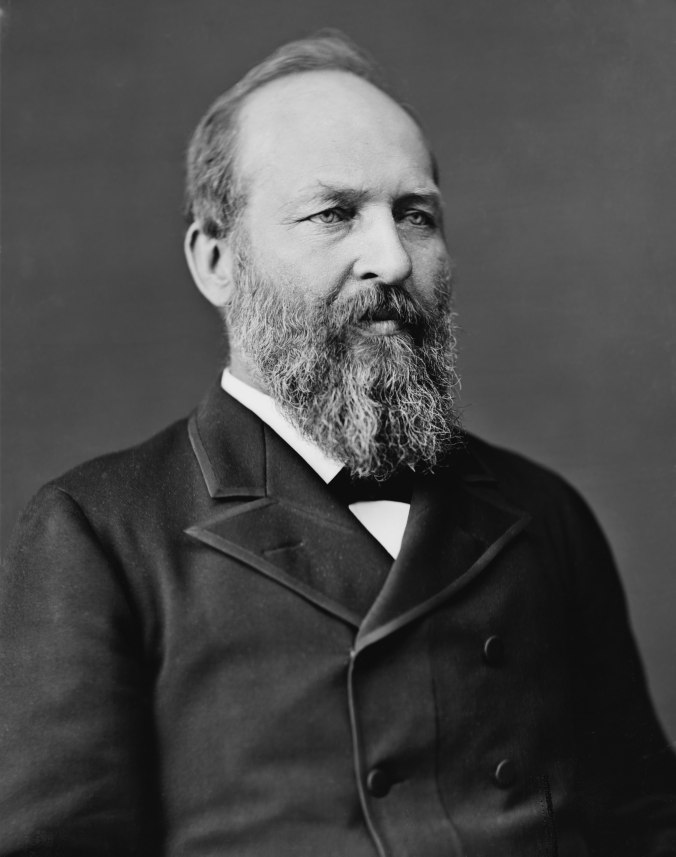Hello and welcome to a very special entry here at the “Church of Christ Celebrities” blog! Today’s post has a slightly different format from our usual approach (more on that below) but as always, feel free to like and share the blog on social media and to offer your thoughts at the Contact page.
Typically, our Standard Operating Procedure is to look into the possible connections between one or two celebrities and Churches of Christ, taking a “Mythbusters”-style approach to either confirming or debunking the supposed link. (Two previous articles have done this for other presidents of various sorts, in case you missed them.) Today, however, I am telling you up front that our three subjects–James Garfield, Lyndon Johnson, and Ronald Reagan–are the only three U.S. presidents to have definite links to churches associated with the Stone-Campbell movement. Correspondingly, our task will be to figure out the exact nature of those connections. Since we have three individuals to discuss, let’s jump right in with the first, James Garfield (1831-1881).

Garfield is best known for being assassinated by an unhappy job seeker named Charles Guiteau in the first (and, of course, only) year of his presidency. Despite the relative historical oblivion into which he has since fallen, however, Garfield was a highly accomplished individual, having served as a brigadier general for the Union during the Civil War and as a delegate to the U.S. House of Representatives from his home state of Ohio. During his short presidency, Garfield fought against corruption in the federal bureaucracy, and his death served as a catalyst for civil service reform under the watch of his vice president and successor Chester Alan Arthur.
Of our three subjects today, Garfield has (by far) the strongest connections to the Stone-Campbell movement, having been baptized into the Disciples of Christ at eighteen and serving as a lay preacher in that group during the 1850s. (1) Garfield’s religiosity has been thoroughly documented in the dissertation of longtime church historian Jerry Rushford, which is available for download at the link provided below. (2) While in Washington, Garfield regularly attended services at the Vermont Avenue Christian Church, (3) though the oft-attributed quotation of “I resign the highest office in the land to become President of the United States” is suspect at best and is not included in Rushford’s dissertation or the standard academic autobiography of Garfield. (4)
Jumping forward in time, our next U.S. president with a Stone-Campbell connection is Lyndon Johnson (1908-1973), who took office after the assassination of John F. Kennedy in 1963. Although his presidency would eventually be dragged down by his involvement in Vietnam, Johnson oversaw the passage of some of the most important pieces of legislation in American history, including the Civil Rights Act of 1964 and Voting Rights Act of 1965, as well as the expansion of the social safety net as part of his “Great Society” and “War on Poverty” initiatives.
Like Garfield, Johnson was a nigh-lifelong member of the Disciples of Christ, regularly attending services during his presidency at the National City Christian Church, where he was made an honorary elder. (5) Johnson’s family was also closely connected with the Stone-Campbell movement; notably, his grandfather Sam Ealy Johnson Sr. became a member of the Disciples of Christ in his youth before converting to another Stone-Campbell-affiliated group, the Christadelphians, in 1879. (6) (Yours truly is writing about the Christadelphians in his dissertation project, so if you have any questions, ask away.)
At last, we come to our third and final subject of the day, Ronald Reagan (1911-2004). After working as an actor and serving as the president of the Screen Actors Guild early in his professional life, Reagan pivoted to politics, becoming governor of California from 1967-1975 and U.S. president from 1981-1989. Reagan’s presidency is most notable for his efforts to reduce federal spending on social welfare programs and to cut taxes, though he also championed large increases in military spending as part of his approach to “fighting” the Cold War.
Of our three subjects, Reagan’s connections to the Stone-Campbell movement (and to organized religion as a whole) are the weakest, albeit still worthy of note. Reagan’s mother Nelle became a member of the Disciples the year before Ronald was born. The future president grew up in that tradition and attended the Disciples-affiliated Eureka College from 1928-1932. As Reagan’s career took off, however, he and wife Nancy became infrequent churchgoers, worshiping occasionally at the Bel Air Presbyterian Church during the 1960s but never becoming members. (7) Reagan still claimed membership in the Disciples into the mid-1970s but effectively stopped attending church services altogether as president during the 1980s. Most tellingly, the National City Christian Church (where Lyndon Johnson had regularly worshiped) held an inauguration service for Reagan in 1981, but Ronald declined the invitation. (8)
That brings us to the end of a lengthier-than-usual entry; hopefully you have learned something or at least enjoyed the ride. See you again in two weeks as we “walk tall” with our next subject here at the “Church of Christ Celebrities” blog!
NOTES
(1) Jerry Rushford, “”Political Disciple: The Relationship Between James A. Garfield and the Disciples of Christ.” PhD dissertation, University of California Santa Barbara, 1977, ix-x.
(2) https://digitalcommons.pepperdine.edu/heritage_center/7/
(3) Rushford, “Political Disciple,” 275.
(4) Allan Peskin, Garfield: A Biography. Kent, OH: Kent State University Press, 1999.
(5) Ronald B. Flowers, “Disciples in the White House,” in Restoring the First-Century Church in the Twenty-First Century: Essays on the Stone-Campbell Restoration Movement in Honor of Don Haymes, eds. Warren Lewis and Hans Rollmann, Eugene, OR: Wipf and Stock Publishers, 2005, 173.
(6) Gregg Cantrell, “Lyndon’s Granddaddy: Samuel Ealy Johnson Sr., Texas Populism, and the Improbable Roots of American Liberalism.” Southwestern Historical Quarterly 118:2, October 2014, 138-139.
(7) Flowers, “Disciples in the White House,” 181-183.
(8) Flowers, “Disciples in the White House,” 184.
Pingback: 40. Powers Boothe (1948-2017) | Church of Christ Celebrities